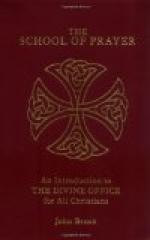Did Hildebrand, Pope Gregory VII. (1073-1086), labour for liturgical reform? Liturgical writers give very different replies. Monsignor Battifol (History of the Roman Breviary, English edition, p. 158) maintains that Gregory made no reform, and that “the Roman office such as we have seen it to be in the times of Charlemagne held its ground at Rome itself, in the customs of the basilicas, without any sensible modification, throughout the tenth and eleventh centuries and even down to the close of the twelfth.” Dom Gueranger holds that Gregory abridged the order of prayers and simplified the liturgy for the use of the Roman curia. It would be difficult at the present time to ascertain accurately the complete form of the office before this revision, but since then it has remained almost identical with what it was at the end of the eleventh century. Dom Baumer agrees with his Benedictine brother that Gregory wrought for liturgical reform. Probably Pope Gregory VII., knowing the decadence which was manifest in liturgical exercises in Rome during the tenth and eleventh centuries, decided to revise the old Roman office which, although it had decayed in Rome, flourished in Germany, France, and other countries. Hence, in his Lenten Synod, 1074, he promulgated the rules he had already drawn up for the Regular Canons of Rome, ordering them to return to the old Roman rite. Thus he may be counted as a reformer, but not as an innovater nor an abridger. But his reform fell on evil days. The great struggle between Church and State about lay investitures had a baneful influence on liturgy, even in Rome itself. The times seemed to call for a modernised (i.e., a shortened) office. The “modernisers” respected the psalter, the curtailment was in the Lectionary. The modernising spirit showed itself in the arrangement and bulk of the office books. The Psalter, Antiphonary, Responsorial,




